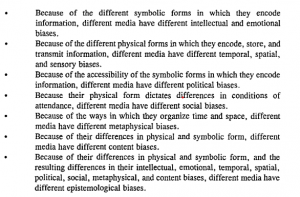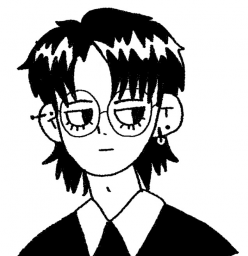Defining “Media Ecology”
In Lum’s introduction to media ecology (2000), he states “media ecology should be viewed as a field of study that is ever-evolving”, as can be seen in the back and forth between scholars. He attempts to position media ecology as an “intellectual tradition and a theoretical perspective”. However, to define media ecology as such is to be limited to passive perception and reception. To “wake up from our environmentally-induced stupor” (de Castell et al., 2014) we need to not just unilaterally, but reciprocally and actively engage with the environment around us. To find ourselves embodied and as embodiment, and also embedded into the environment, perhaps to an extent such that when we reach out to embrace the world, we can also feel the imprint of the “fleshiness” of the world around us.
Form AND aFFORDANCES

Nystrom’s generalizations of forms and their “biases” really intrigued me, though I argue “affordances” seems more fitting, as it has a more positive connotation of what it has to “offer”.
I make this distinction, as “affordances” looks for the “potential” rather than the “limitations”, and I think that is a core essential part of “media ecology”. The “potential” for media to have impact to “create the environment or symbolic and cognitive structure in which people construct the world they know and understand, as well as its social, economic, political and cultural consequences” (Lum, 2000, p.2)
Selbstbildung – mediation bewteen organism and environment
To see “potential” is to harness the human agency that we have in making meaning of the world around us in the ways that we are situated in, as Geddes argues “no living organism can be understood except in the terms of the total environment in which it functioned” (Strate & Lum, 2000, p. 68).
However, the boundaries can seem quite blurry, where does an organism end and the environment begin? Just as the physical form of media is as important as the symbolic form it conveys, and that “the content of a medium is another medium” to the extent of “understanding media as environment and environment as media”, there seems to be systems within systems that are interrelated, connected, and can be two things either/or and both at once. Like “building” in the nominal sense contributing to part of the city landscape as container, provides a space or activities as an interface, and engaging with the space through social practice as a way to create meaning (de Castell et al., 2014). What is built simultaneously builds new substance that feeds into itself, and continues to be used to create new substance. The self-recursion of constant mediation between organism and environment as “selbstbildung” is what I believe allows one to feel embodied and embedded with and within the environment in which it relates to the self.
Meaning-Making through Learning to Play
Going back to Lum’s “ever-evolving field” of media ecology, and the concepts of affordances and selbstbildung, I believe it is necessary to approach it from a production pedagogy and “attend to verbs” — by taking action to disrupt the inertia of the environment to “incite critical engagement and thought, unseating our concepts and disorienting our percepts” as McLuhan puts it (de Castell et al., 2014). Mumford argues what makes human species unique is not tools, industry or labor, rather, language, art and play. Therefore, echoing the notion of de Castell et al. (2014, p. 90), I would like to add the element of “play” as the foundation of “learning” extending to the intentional act of “designing” as the process of meaning-making.
Play disrupts the current equilibrium to question what is known, and provides momentum to give rise to creation. To create and “engage in building” in a controlled, perhaps methodological way is to learn how to “mediate interconnectively between and among agents both human and not” such that “education is a practice of building“. To build sustainably is to create a “system that produces its own future capacity”, and reiterates the “active, situated, knowledgeable and skillfully productive” act of education to create an “ecology that demands the inhabitants to learn themselves, how to maintain it” such that it reaches equilibrium until it is disrupted again and again, over and over, with its every iteration and evolution. To continue this natural recursion is to allow the world to affect and envelope us in the ways that it does, and to entwine ourselves into the curves of the landscape, to fully feel its embrace and to embrace it back with just as muchness, unequivocally.
References
Castell, S. d., Droumeva, M., & Jenson, J. (2014). Building as interface: Sustainable educational ecologies. Medienpädagogik, 24(24), 75-93. https://doi.org/10.21240/mpaed/24/2014.09.08.X
Lum, C. M. K. (2000). Introduction: The intellectual roots of media ecology. The New Jersey Journal of Communication, 8(1), 1-7. https://doi.org/10.1080/15456870009367375
Strate, L., & Lum, C. M. K. (2000). Lewis mumford and the ecology of technics. The New Jersey Journal of Communication, 8(1), 56-78. https://doi.org/10.1080/15456870009367379
